Climate Change and Global Political Economy
VerifiedAdded on 2020/04/21
|15
|3784
|34
AI Summary
This assignment delves into the complex relationship between climate change and global political economy. It examines how international power structures influence climate policies, explores the ethical considerations of distributive justice in addressing climate impacts, and analyzes the role of technology in mitigating climate change. The provided texts offer diverse perspectives on these interconnected issues, ranging from academic research to policy reports and thought pieces.
Contribute Materials
Your contribution can guide someone’s learning journey. Share your
documents today.
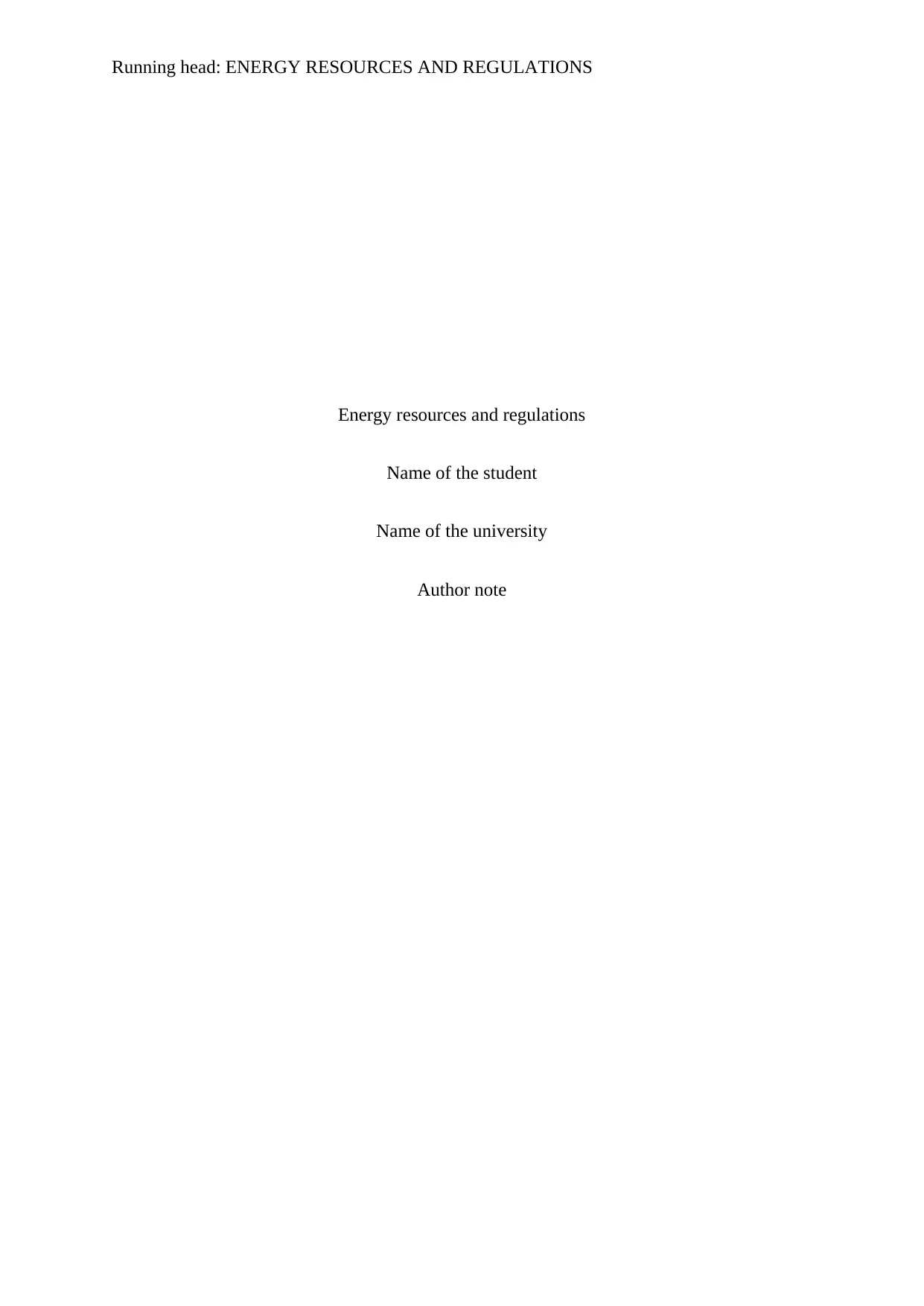
Running head: ENERGY RESOURCES AND REGULATIONS
Energy resources and regulations
Name of the student
Name of the university
Author note
Energy resources and regulations
Name of the student
Name of the university
Author note
Secure Best Marks with AI Grader
Need help grading? Try our AI Grader for instant feedback on your assignments.
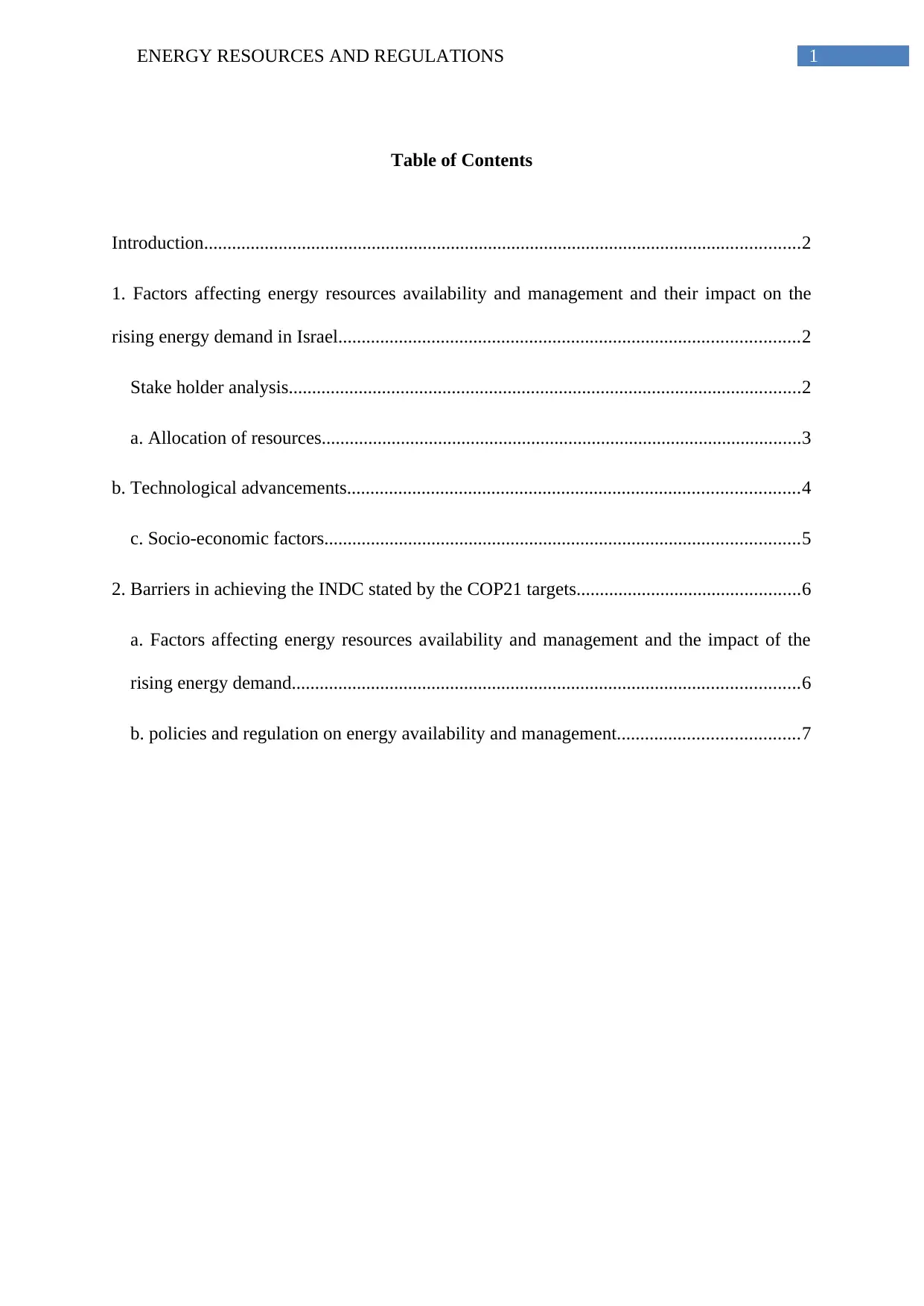
1ENERGY RESOURCES AND REGULATIONS
Table of Contents
Introduction................................................................................................................................2
1. Factors affecting energy resources availability and management and their impact on the
rising energy demand in Israel...................................................................................................2
Stake holder analysis..............................................................................................................2
a. Allocation of resources.......................................................................................................3
b. Technological advancements.................................................................................................4
c. Socio-economic factors......................................................................................................5
2. Barriers in achieving the INDC stated by the COP21 targets................................................6
a. Factors affecting energy resources availability and management and the impact of the
rising energy demand.............................................................................................................6
b. policies and regulation on energy availability and management.......................................7
Table of Contents
Introduction................................................................................................................................2
1. Factors affecting energy resources availability and management and their impact on the
rising energy demand in Israel...................................................................................................2
Stake holder analysis..............................................................................................................2
a. Allocation of resources.......................................................................................................3
b. Technological advancements.................................................................................................4
c. Socio-economic factors......................................................................................................5
2. Barriers in achieving the INDC stated by the COP21 targets................................................6
a. Factors affecting energy resources availability and management and the impact of the
rising energy demand.............................................................................................................6
b. policies and regulation on energy availability and management.......................................7
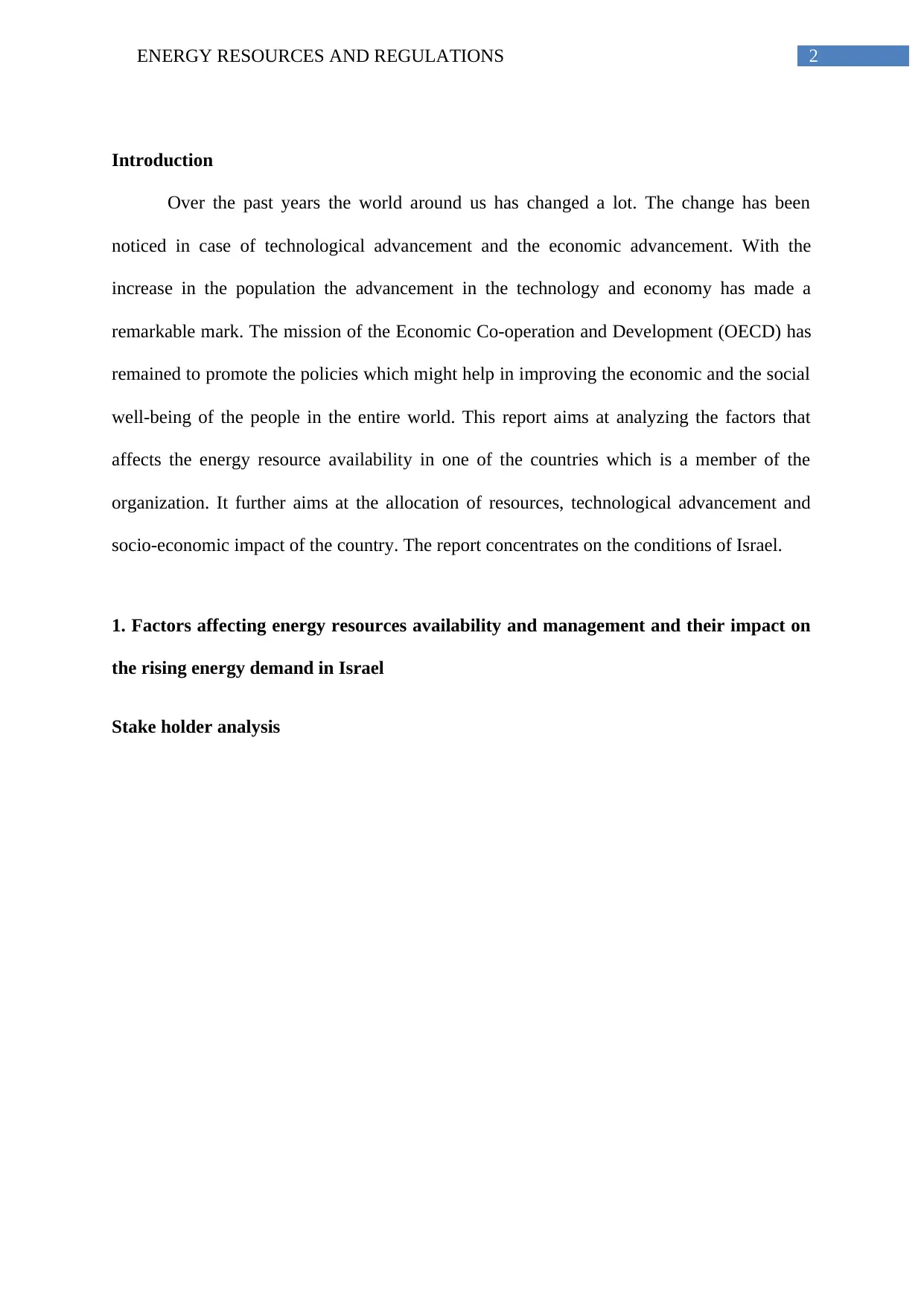
2ENERGY RESOURCES AND REGULATIONS
Introduction
Over the past years the world around us has changed a lot. The change has been
noticed in case of technological advancement and the economic advancement. With the
increase in the population the advancement in the technology and economy has made a
remarkable mark. The mission of the Economic Co-operation and Development (OECD) has
remained to promote the policies which might help in improving the economic and the social
well-being of the people in the entire world. This report aims at analyzing the factors that
affects the energy resource availability in one of the countries which is a member of the
organization. It further aims at the allocation of resources, technological advancement and
socio-economic impact of the country. The report concentrates on the conditions of Israel.
1. Factors affecting energy resources availability and management and their impact on
the rising energy demand in Israel
Stake holder analysis
Introduction
Over the past years the world around us has changed a lot. The change has been
noticed in case of technological advancement and the economic advancement. With the
increase in the population the advancement in the technology and economy has made a
remarkable mark. The mission of the Economic Co-operation and Development (OECD) has
remained to promote the policies which might help in improving the economic and the social
well-being of the people in the entire world. This report aims at analyzing the factors that
affects the energy resource availability in one of the countries which is a member of the
organization. It further aims at the allocation of resources, technological advancement and
socio-economic impact of the country. The report concentrates on the conditions of Israel.
1. Factors affecting energy resources availability and management and their impact on
the rising energy demand in Israel
Stake holder analysis
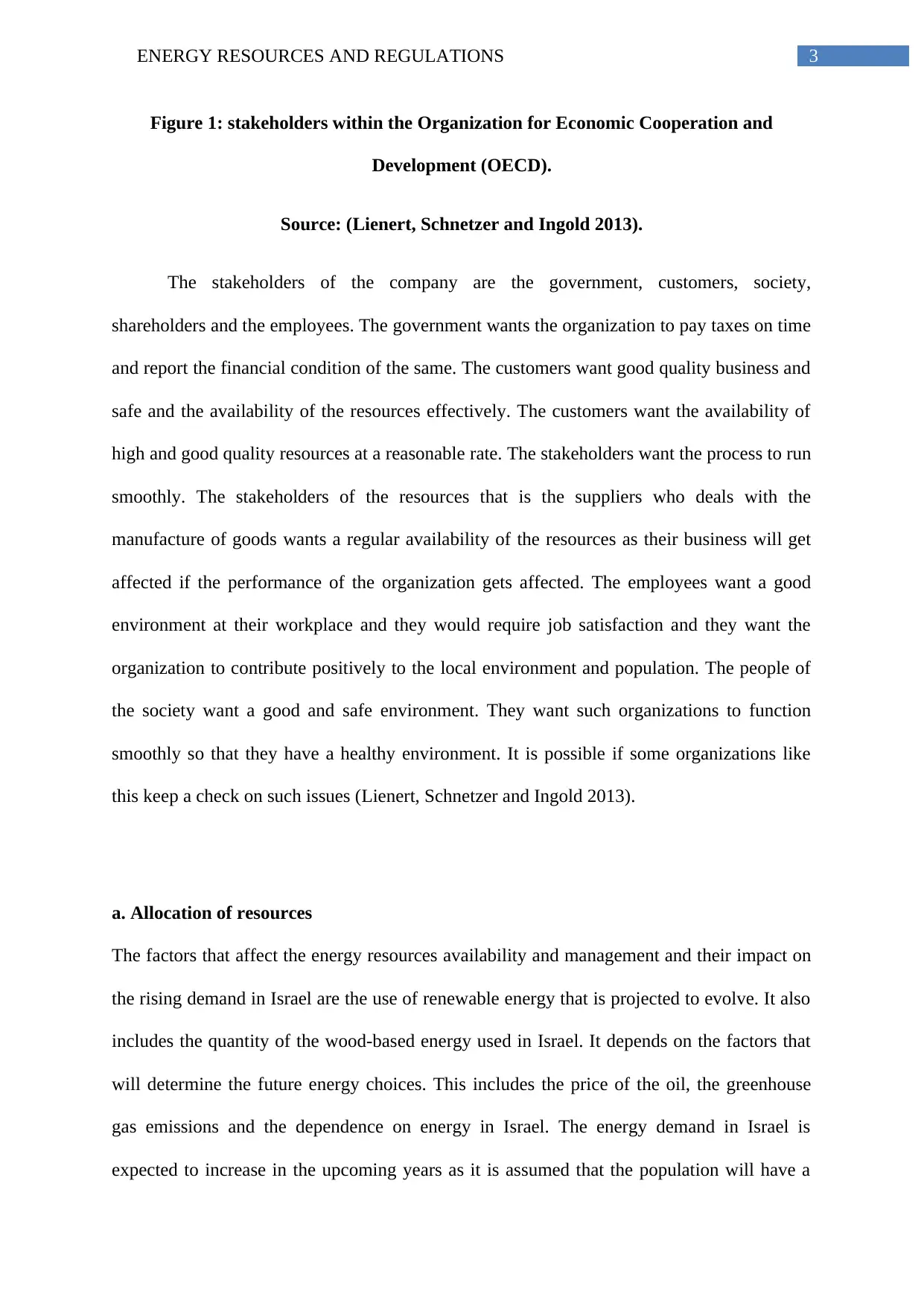
3ENERGY RESOURCES AND REGULATIONS
Figure 1: stakeholders within the Organization for Economic Cooperation and
Development (OECD).
Source: (Lienert, Schnetzer and Ingold 2013).
The stakeholders of the company are the government, customers, society,
shareholders and the employees. The government wants the organization to pay taxes on time
and report the financial condition of the same. The customers want good quality business and
safe and the availability of the resources effectively. The customers want the availability of
high and good quality resources at a reasonable rate. The stakeholders want the process to run
smoothly. The stakeholders of the resources that is the suppliers who deals with the
manufacture of goods wants a regular availability of the resources as their business will get
affected if the performance of the organization gets affected. The employees want a good
environment at their workplace and they would require job satisfaction and they want the
organization to contribute positively to the local environment and population. The people of
the society want a good and safe environment. They want such organizations to function
smoothly so that they have a healthy environment. It is possible if some organizations like
this keep a check on such issues (Lienert, Schnetzer and Ingold 2013).
a. Allocation of resources
The factors that affect the energy resources availability and management and their impact on
the rising demand in Israel are the use of renewable energy that is projected to evolve. It also
includes the quantity of the wood-based energy used in Israel. It depends on the factors that
will determine the future energy choices. This includes the price of the oil, the greenhouse
gas emissions and the dependence on energy in Israel. The energy demand in Israel is
expected to increase in the upcoming years as it is assumed that the population will have a
Figure 1: stakeholders within the Organization for Economic Cooperation and
Development (OECD).
Source: (Lienert, Schnetzer and Ingold 2013).
The stakeholders of the company are the government, customers, society,
shareholders and the employees. The government wants the organization to pay taxes on time
and report the financial condition of the same. The customers want good quality business and
safe and the availability of the resources effectively. The customers want the availability of
high and good quality resources at a reasonable rate. The stakeholders want the process to run
smoothly. The stakeholders of the resources that is the suppliers who deals with the
manufacture of goods wants a regular availability of the resources as their business will get
affected if the performance of the organization gets affected. The employees want a good
environment at their workplace and they would require job satisfaction and they want the
organization to contribute positively to the local environment and population. The people of
the society want a good and safe environment. They want such organizations to function
smoothly so that they have a healthy environment. It is possible if some organizations like
this keep a check on such issues (Lienert, Schnetzer and Ingold 2013).
a. Allocation of resources
The factors that affect the energy resources availability and management and their impact on
the rising demand in Israel are the use of renewable energy that is projected to evolve. It also
includes the quantity of the wood-based energy used in Israel. It depends on the factors that
will determine the future energy choices. This includes the price of the oil, the greenhouse
gas emissions and the dependence on energy in Israel. The energy demand in Israel is
expected to increase in the upcoming years as it is assumed that the population will have a
Secure Best Marks with AI Grader
Need help grading? Try our AI Grader for instant feedback on your assignments.
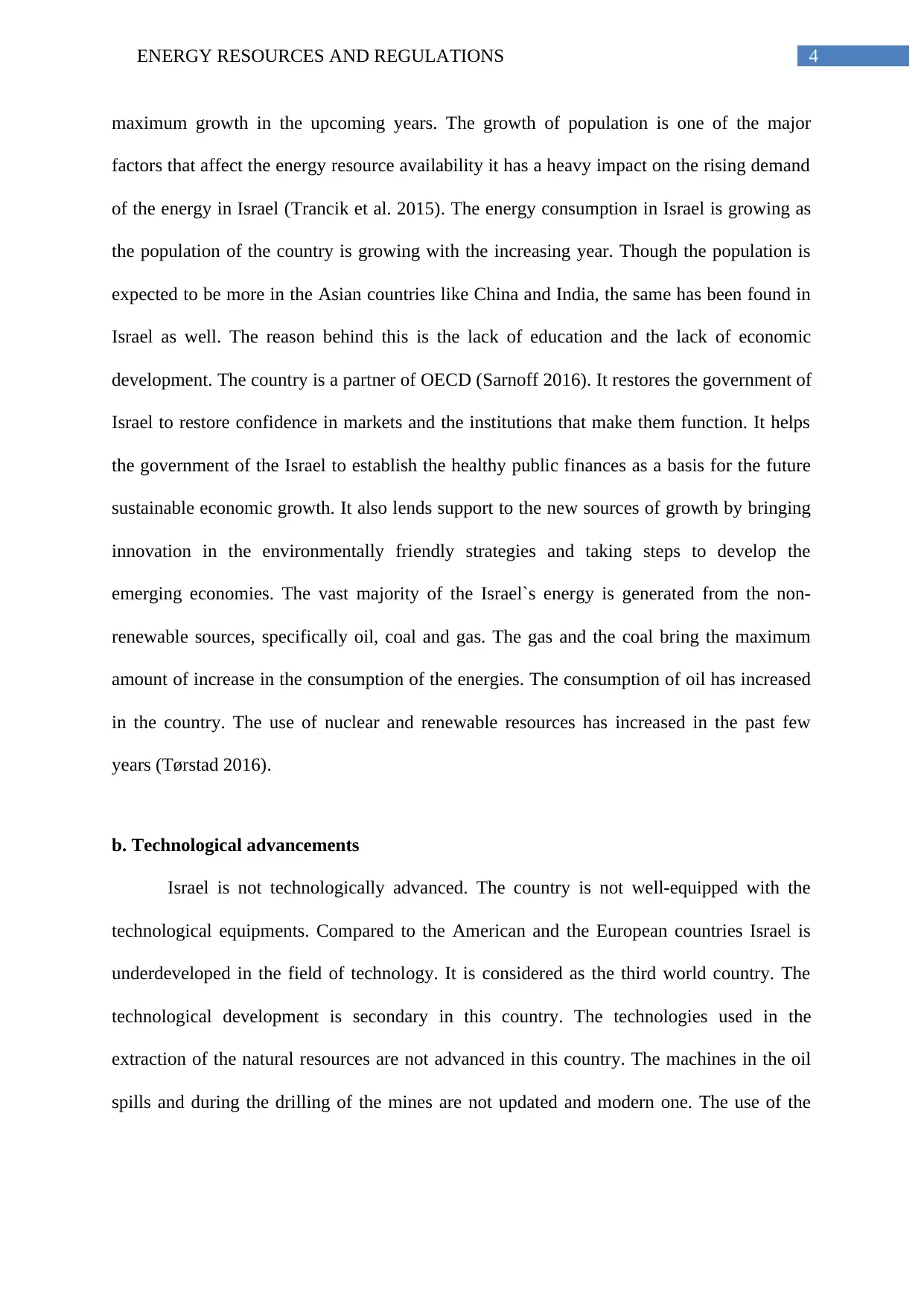
4ENERGY RESOURCES AND REGULATIONS
maximum growth in the upcoming years. The growth of population is one of the major
factors that affect the energy resource availability it has a heavy impact on the rising demand
of the energy in Israel (Trancik et al. 2015). The energy consumption in Israel is growing as
the population of the country is growing with the increasing year. Though the population is
expected to be more in the Asian countries like China and India, the same has been found in
Israel as well. The reason behind this is the lack of education and the lack of economic
development. The country is a partner of OECD (Sarnoff 2016). It restores the government of
Israel to restore confidence in markets and the institutions that make them function. It helps
the government of the Israel to establish the healthy public finances as a basis for the future
sustainable economic growth. It also lends support to the new sources of growth by bringing
innovation in the environmentally friendly strategies and taking steps to develop the
emerging economies. The vast majority of the Israel`s energy is generated from the non-
renewable sources, specifically oil, coal and gas. The gas and the coal bring the maximum
amount of increase in the consumption of the energies. The consumption of oil has increased
in the country. The use of nuclear and renewable resources has increased in the past few
years (Tørstad 2016).
b. Technological advancements
Israel is not technologically advanced. The country is not well-equipped with the
technological equipments. Compared to the American and the European countries Israel is
underdeveloped in the field of technology. It is considered as the third world country. The
technological development is secondary in this country. The technologies used in the
extraction of the natural resources are not advanced in this country. The machines in the oil
spills and during the drilling of the mines are not updated and modern one. The use of the
maximum growth in the upcoming years. The growth of population is one of the major
factors that affect the energy resource availability it has a heavy impact on the rising demand
of the energy in Israel (Trancik et al. 2015). The energy consumption in Israel is growing as
the population of the country is growing with the increasing year. Though the population is
expected to be more in the Asian countries like China and India, the same has been found in
Israel as well. The reason behind this is the lack of education and the lack of economic
development. The country is a partner of OECD (Sarnoff 2016). It restores the government of
Israel to restore confidence in markets and the institutions that make them function. It helps
the government of the Israel to establish the healthy public finances as a basis for the future
sustainable economic growth. It also lends support to the new sources of growth by bringing
innovation in the environmentally friendly strategies and taking steps to develop the
emerging economies. The vast majority of the Israel`s energy is generated from the non-
renewable sources, specifically oil, coal and gas. The gas and the coal bring the maximum
amount of increase in the consumption of the energies. The consumption of oil has increased
in the country. The use of nuclear and renewable resources has increased in the past few
years (Tørstad 2016).
b. Technological advancements
Israel is not technologically advanced. The country is not well-equipped with the
technological equipments. Compared to the American and the European countries Israel is
underdeveloped in the field of technology. It is considered as the third world country. The
technological development is secondary in this country. The technologies used in the
extraction of the natural resources are not advanced in this country. The machines in the oil
spills and during the drilling of the mines are not updated and modern one. The use of the
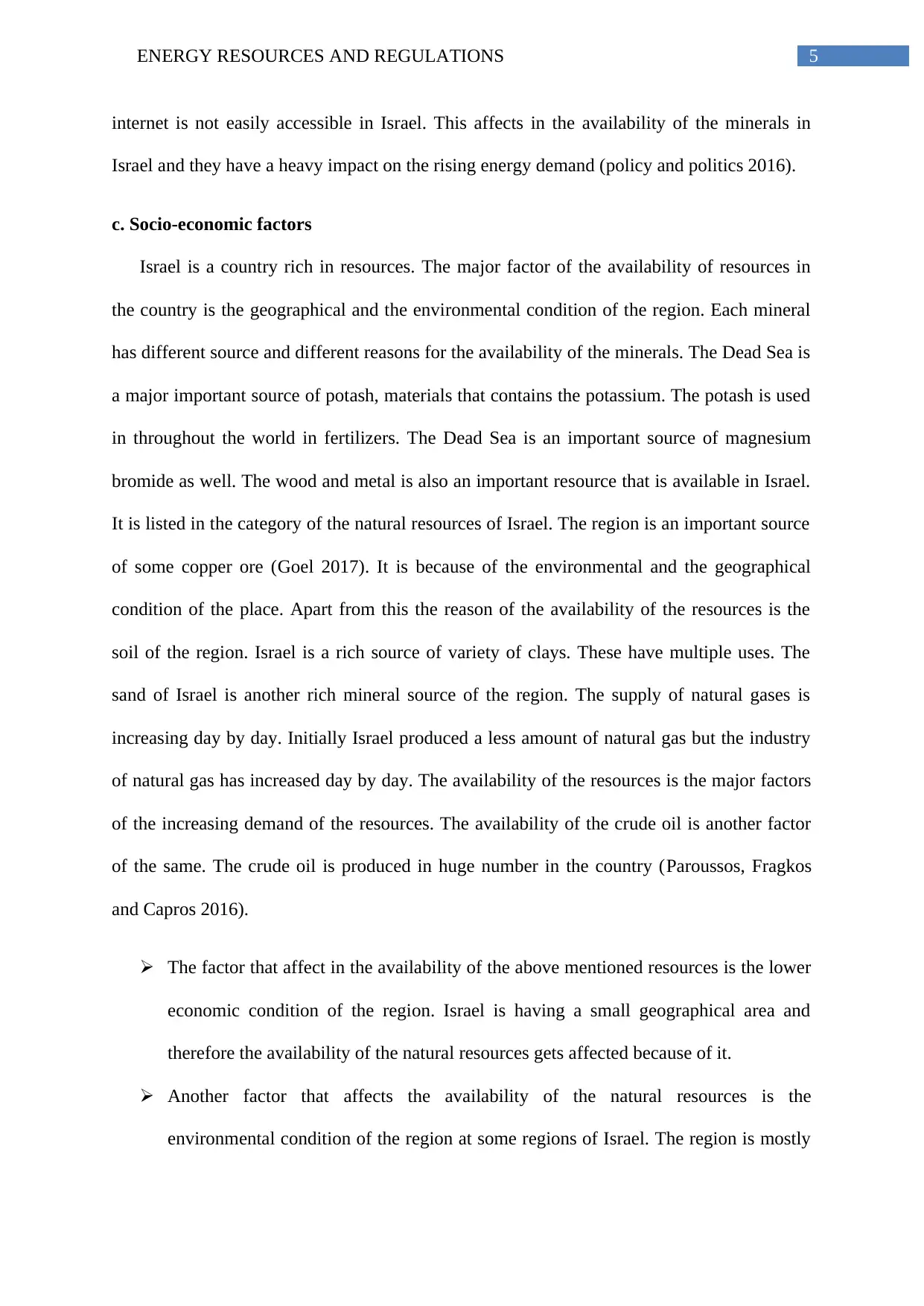
5ENERGY RESOURCES AND REGULATIONS
internet is not easily accessible in Israel. This affects in the availability of the minerals in
Israel and they have a heavy impact on the rising energy demand (policy and politics 2016).
c. Socio-economic factors
Israel is a country rich in resources. The major factor of the availability of resources in
the country is the geographical and the environmental condition of the region. Each mineral
has different source and different reasons for the availability of the minerals. The Dead Sea is
a major important source of potash, materials that contains the potassium. The potash is used
in throughout the world in fertilizers. The Dead Sea is an important source of magnesium
bromide as well. The wood and metal is also an important resource that is available in Israel.
It is listed in the category of the natural resources of Israel. The region is an important source
of some copper ore (Goel 2017). It is because of the environmental and the geographical
condition of the place. Apart from this the reason of the availability of the resources is the
soil of the region. Israel is a rich source of variety of clays. These have multiple uses. The
sand of Israel is another rich mineral source of the region. The supply of natural gases is
increasing day by day. Initially Israel produced a less amount of natural gas but the industry
of natural gas has increased day by day. The availability of the resources is the major factors
of the increasing demand of the resources. The availability of the crude oil is another factor
of the same. The crude oil is produced in huge number in the country (Paroussos, Fragkos
and Capros 2016).
The factor that affect in the availability of the above mentioned resources is the lower
economic condition of the region. Israel is having a small geographical area and
therefore the availability of the natural resources gets affected because of it.
Another factor that affects the availability of the natural resources is the
environmental condition of the region at some regions of Israel. The region is mostly
internet is not easily accessible in Israel. This affects in the availability of the minerals in
Israel and they have a heavy impact on the rising energy demand (policy and politics 2016).
c. Socio-economic factors
Israel is a country rich in resources. The major factor of the availability of resources in
the country is the geographical and the environmental condition of the region. Each mineral
has different source and different reasons for the availability of the minerals. The Dead Sea is
a major important source of potash, materials that contains the potassium. The potash is used
in throughout the world in fertilizers. The Dead Sea is an important source of magnesium
bromide as well. The wood and metal is also an important resource that is available in Israel.
It is listed in the category of the natural resources of Israel. The region is an important source
of some copper ore (Goel 2017). It is because of the environmental and the geographical
condition of the place. Apart from this the reason of the availability of the resources is the
soil of the region. Israel is a rich source of variety of clays. These have multiple uses. The
sand of Israel is another rich mineral source of the region. The supply of natural gases is
increasing day by day. Initially Israel produced a less amount of natural gas but the industry
of natural gas has increased day by day. The availability of the resources is the major factors
of the increasing demand of the resources. The availability of the crude oil is another factor
of the same. The crude oil is produced in huge number in the country (Paroussos, Fragkos
and Capros 2016).
The factor that affect in the availability of the above mentioned resources is the lower
economic condition of the region. Israel is having a small geographical area and
therefore the availability of the natural resources gets affected because of it.
Another factor that affects the availability of the natural resources is the
environmental condition of the region at some regions of Israel. The region is mostly
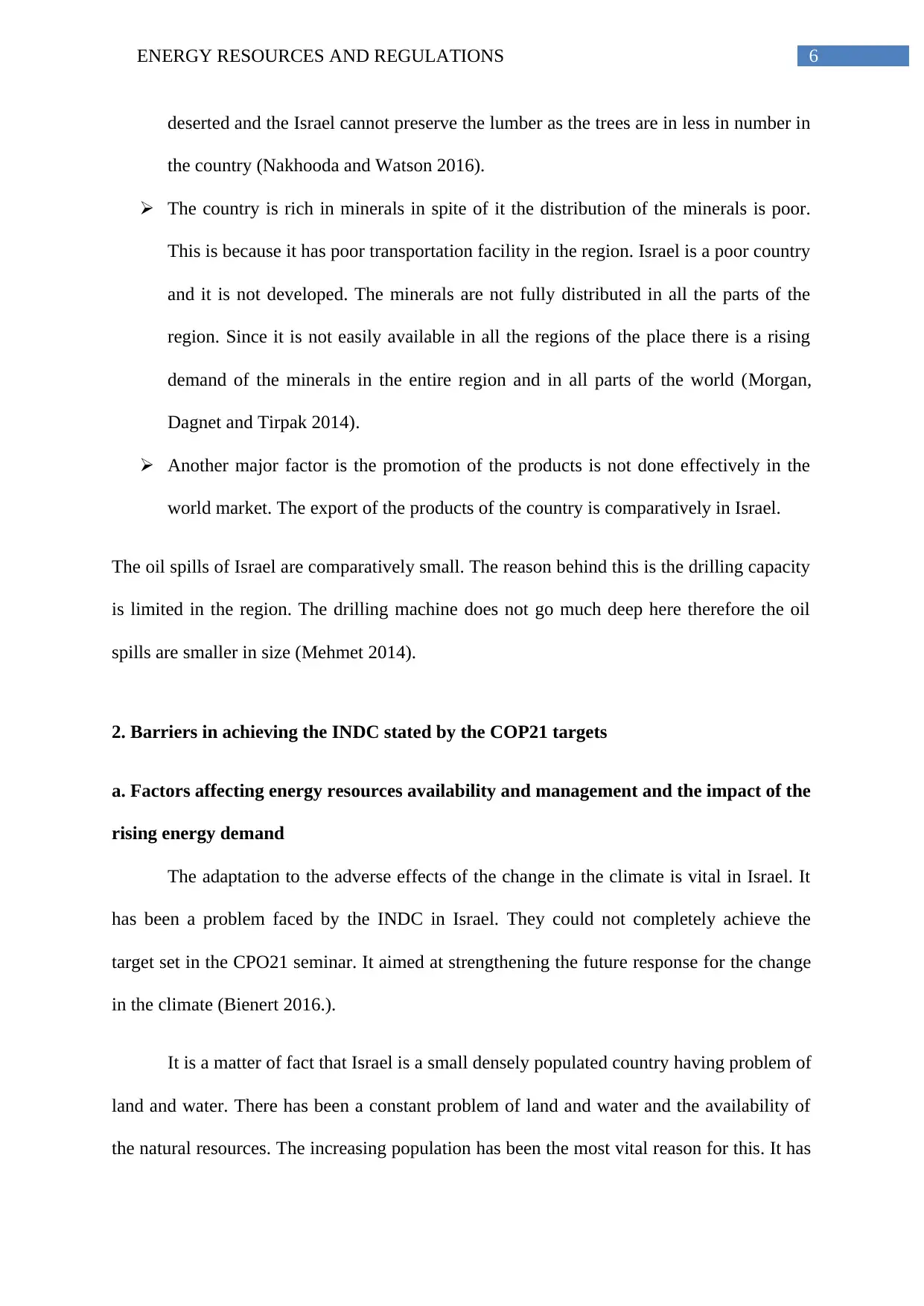
6ENERGY RESOURCES AND REGULATIONS
deserted and the Israel cannot preserve the lumber as the trees are in less in number in
the country (Nakhooda and Watson 2016).
The country is rich in minerals in spite of it the distribution of the minerals is poor.
This is because it has poor transportation facility in the region. Israel is a poor country
and it is not developed. The minerals are not fully distributed in all the parts of the
region. Since it is not easily available in all the regions of the place there is a rising
demand of the minerals in the entire region and in all parts of the world (Morgan,
Dagnet and Tirpak 2014).
Another major factor is the promotion of the products is not done effectively in the
world market. The export of the products of the country is comparatively in Israel.
The oil spills of Israel are comparatively small. The reason behind this is the drilling capacity
is limited in the region. The drilling machine does not go much deep here therefore the oil
spills are smaller in size (Mehmet 2014).
2. Barriers in achieving the INDC stated by the COP21 targets
a. Factors affecting energy resources availability and management and the impact of the
rising energy demand
The adaptation to the adverse effects of the change in the climate is vital in Israel. It
has been a problem faced by the INDC in Israel. They could not completely achieve the
target set in the CPO21 seminar. It aimed at strengthening the future response for the change
in the climate (Bienert 2016.).
It is a matter of fact that Israel is a small densely populated country having problem of
land and water. There has been a constant problem of land and water and the availability of
the natural resources. The increasing population has been the most vital reason for this. It has
deserted and the Israel cannot preserve the lumber as the trees are in less in number in
the country (Nakhooda and Watson 2016).
The country is rich in minerals in spite of it the distribution of the minerals is poor.
This is because it has poor transportation facility in the region. Israel is a poor country
and it is not developed. The minerals are not fully distributed in all the parts of the
region. Since it is not easily available in all the regions of the place there is a rising
demand of the minerals in the entire region and in all parts of the world (Morgan,
Dagnet and Tirpak 2014).
Another major factor is the promotion of the products is not done effectively in the
world market. The export of the products of the country is comparatively in Israel.
The oil spills of Israel are comparatively small. The reason behind this is the drilling capacity
is limited in the region. The drilling machine does not go much deep here therefore the oil
spills are smaller in size (Mehmet 2014).
2. Barriers in achieving the INDC stated by the COP21 targets
a. Factors affecting energy resources availability and management and the impact of the
rising energy demand
The adaptation to the adverse effects of the change in the climate is vital in Israel. It
has been a problem faced by the INDC in Israel. They could not completely achieve the
target set in the CPO21 seminar. It aimed at strengthening the future response for the change
in the climate (Bienert 2016.).
It is a matter of fact that Israel is a small densely populated country having problem of
land and water. There has been a constant problem of land and water and the availability of
the natural resources. The increasing population has been the most vital reason for this. It has
Paraphrase This Document
Need a fresh take? Get an instant paraphrase of this document with our AI Paraphraser
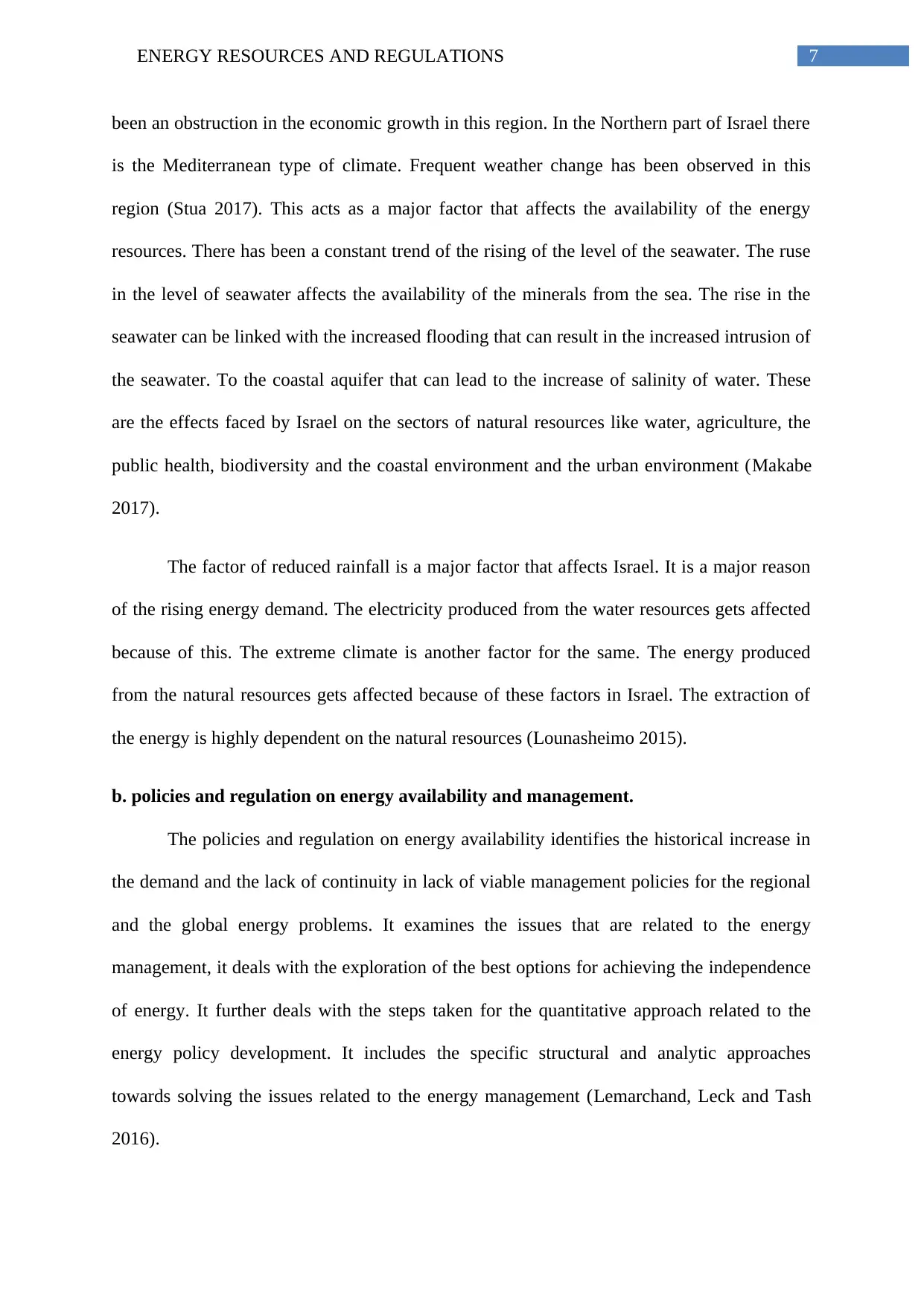
7ENERGY RESOURCES AND REGULATIONS
been an obstruction in the economic growth in this region. In the Northern part of Israel there
is the Mediterranean type of climate. Frequent weather change has been observed in this
region (Stua 2017). This acts as a major factor that affects the availability of the energy
resources. There has been a constant trend of the rising of the level of the seawater. The ruse
in the level of seawater affects the availability of the minerals from the sea. The rise in the
seawater can be linked with the increased flooding that can result in the increased intrusion of
the seawater. To the coastal aquifer that can lead to the increase of salinity of water. These
are the effects faced by Israel on the sectors of natural resources like water, agriculture, the
public health, biodiversity and the coastal environment and the urban environment (Makabe
2017).
The factor of reduced rainfall is a major factor that affects Israel. It is a major reason
of the rising energy demand. The electricity produced from the water resources gets affected
because of this. The extreme climate is another factor for the same. The energy produced
from the natural resources gets affected because of these factors in Israel. The extraction of
the energy is highly dependent on the natural resources (Lounasheimo 2015).
b. policies and regulation on energy availability and management.
The policies and regulation on energy availability identifies the historical increase in
the demand and the lack of continuity in lack of viable management policies for the regional
and the global energy problems. It examines the issues that are related to the energy
management, it deals with the exploration of the best options for achieving the independence
of energy. It further deals with the steps taken for the quantitative approach related to the
energy policy development. It includes the specific structural and analytic approaches
towards solving the issues related to the energy management (Lemarchand, Leck and Tash
2016).
been an obstruction in the economic growth in this region. In the Northern part of Israel there
is the Mediterranean type of climate. Frequent weather change has been observed in this
region (Stua 2017). This acts as a major factor that affects the availability of the energy
resources. There has been a constant trend of the rising of the level of the seawater. The ruse
in the level of seawater affects the availability of the minerals from the sea. The rise in the
seawater can be linked with the increased flooding that can result in the increased intrusion of
the seawater. To the coastal aquifer that can lead to the increase of salinity of water. These
are the effects faced by Israel on the sectors of natural resources like water, agriculture, the
public health, biodiversity and the coastal environment and the urban environment (Makabe
2017).
The factor of reduced rainfall is a major factor that affects Israel. It is a major reason
of the rising energy demand. The electricity produced from the water resources gets affected
because of this. The extreme climate is another factor for the same. The energy produced
from the natural resources gets affected because of these factors in Israel. The extraction of
the energy is highly dependent on the natural resources (Lounasheimo 2015).
b. policies and regulation on energy availability and management.
The policies and regulation on energy availability identifies the historical increase in
the demand and the lack of continuity in lack of viable management policies for the regional
and the global energy problems. It examines the issues that are related to the energy
management, it deals with the exploration of the best options for achieving the independence
of energy. It further deals with the steps taken for the quantitative approach related to the
energy policy development. It includes the specific structural and analytic approaches
towards solving the issues related to the energy management (Lemarchand, Leck and Tash
2016).
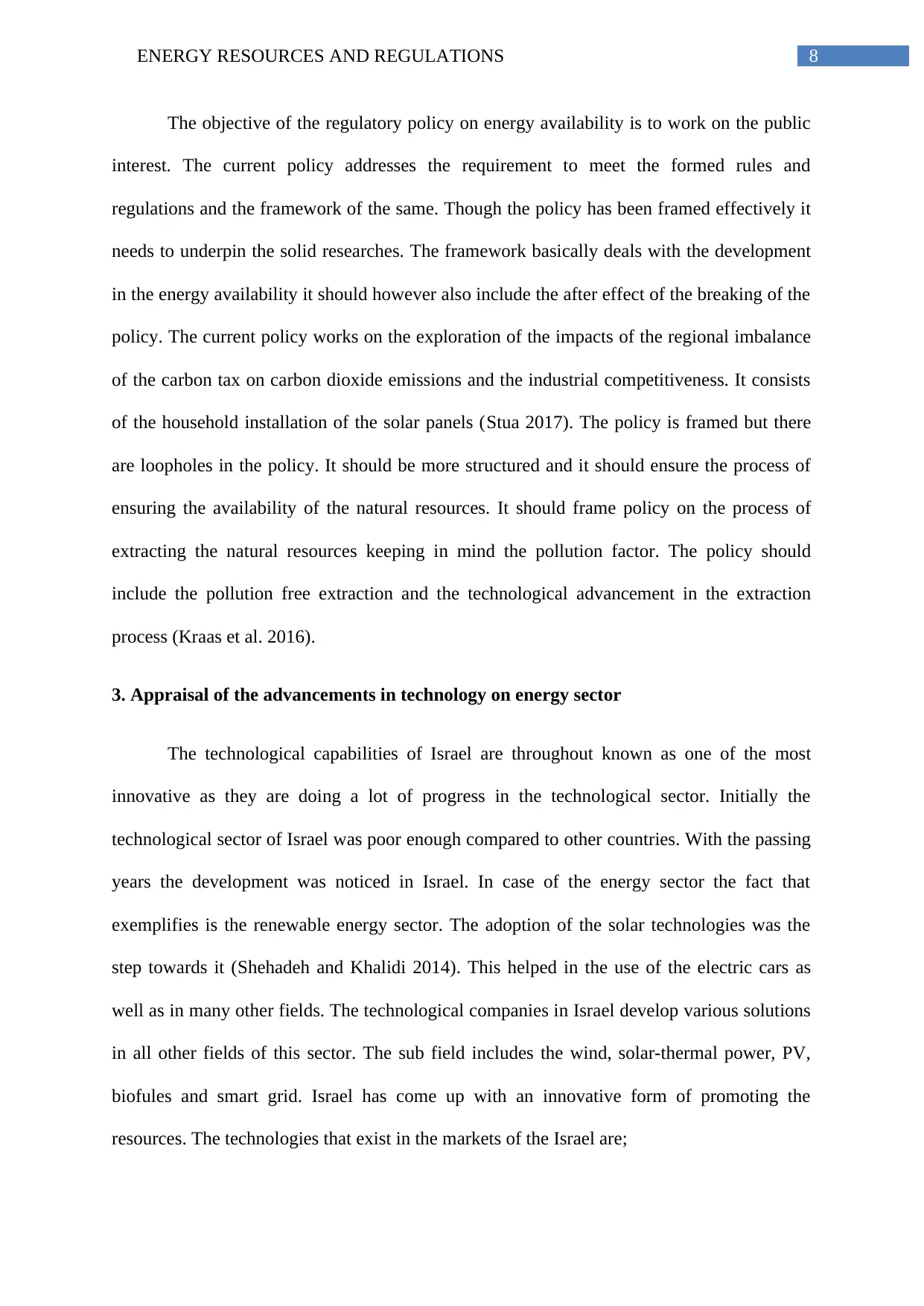
8ENERGY RESOURCES AND REGULATIONS
The objective of the regulatory policy on energy availability is to work on the public
interest. The current policy addresses the requirement to meet the formed rules and
regulations and the framework of the same. Though the policy has been framed effectively it
needs to underpin the solid researches. The framework basically deals with the development
in the energy availability it should however also include the after effect of the breaking of the
policy. The current policy works on the exploration of the impacts of the regional imbalance
of the carbon tax on carbon dioxide emissions and the industrial competitiveness. It consists
of the household installation of the solar panels (Stua 2017). The policy is framed but there
are loopholes in the policy. It should be more structured and it should ensure the process of
ensuring the availability of the natural resources. It should frame policy on the process of
extracting the natural resources keeping in mind the pollution factor. The policy should
include the pollution free extraction and the technological advancement in the extraction
process (Kraas et al. 2016).
3. Appraisal of the advancements in technology on energy sector
The technological capabilities of Israel are throughout known as one of the most
innovative as they are doing a lot of progress in the technological sector. Initially the
technological sector of Israel was poor enough compared to other countries. With the passing
years the development was noticed in Israel. In case of the energy sector the fact that
exemplifies is the renewable energy sector. The adoption of the solar technologies was the
step towards it (Shehadeh and Khalidi 2014). This helped in the use of the electric cars as
well as in many other fields. The technological companies in Israel develop various solutions
in all other fields of this sector. The sub field includes the wind, solar-thermal power, PV,
biofules and smart grid. Israel has come up with an innovative form of promoting the
resources. The technologies that exist in the markets of the Israel are;
The objective of the regulatory policy on energy availability is to work on the public
interest. The current policy addresses the requirement to meet the formed rules and
regulations and the framework of the same. Though the policy has been framed effectively it
needs to underpin the solid researches. The framework basically deals with the development
in the energy availability it should however also include the after effect of the breaking of the
policy. The current policy works on the exploration of the impacts of the regional imbalance
of the carbon tax on carbon dioxide emissions and the industrial competitiveness. It consists
of the household installation of the solar panels (Stua 2017). The policy is framed but there
are loopholes in the policy. It should be more structured and it should ensure the process of
ensuring the availability of the natural resources. It should frame policy on the process of
extracting the natural resources keeping in mind the pollution factor. The policy should
include the pollution free extraction and the technological advancement in the extraction
process (Kraas et al. 2016).
3. Appraisal of the advancements in technology on energy sector
The technological capabilities of Israel are throughout known as one of the most
innovative as they are doing a lot of progress in the technological sector. Initially the
technological sector of Israel was poor enough compared to other countries. With the passing
years the development was noticed in Israel. In case of the energy sector the fact that
exemplifies is the renewable energy sector. The adoption of the solar technologies was the
step towards it (Shehadeh and Khalidi 2014). This helped in the use of the electric cars as
well as in many other fields. The technological companies in Israel develop various solutions
in all other fields of this sector. The sub field includes the wind, solar-thermal power, PV,
biofules and smart grid. Israel has come up with an innovative form of promoting the
resources. The technologies that exist in the markets of the Israel are;
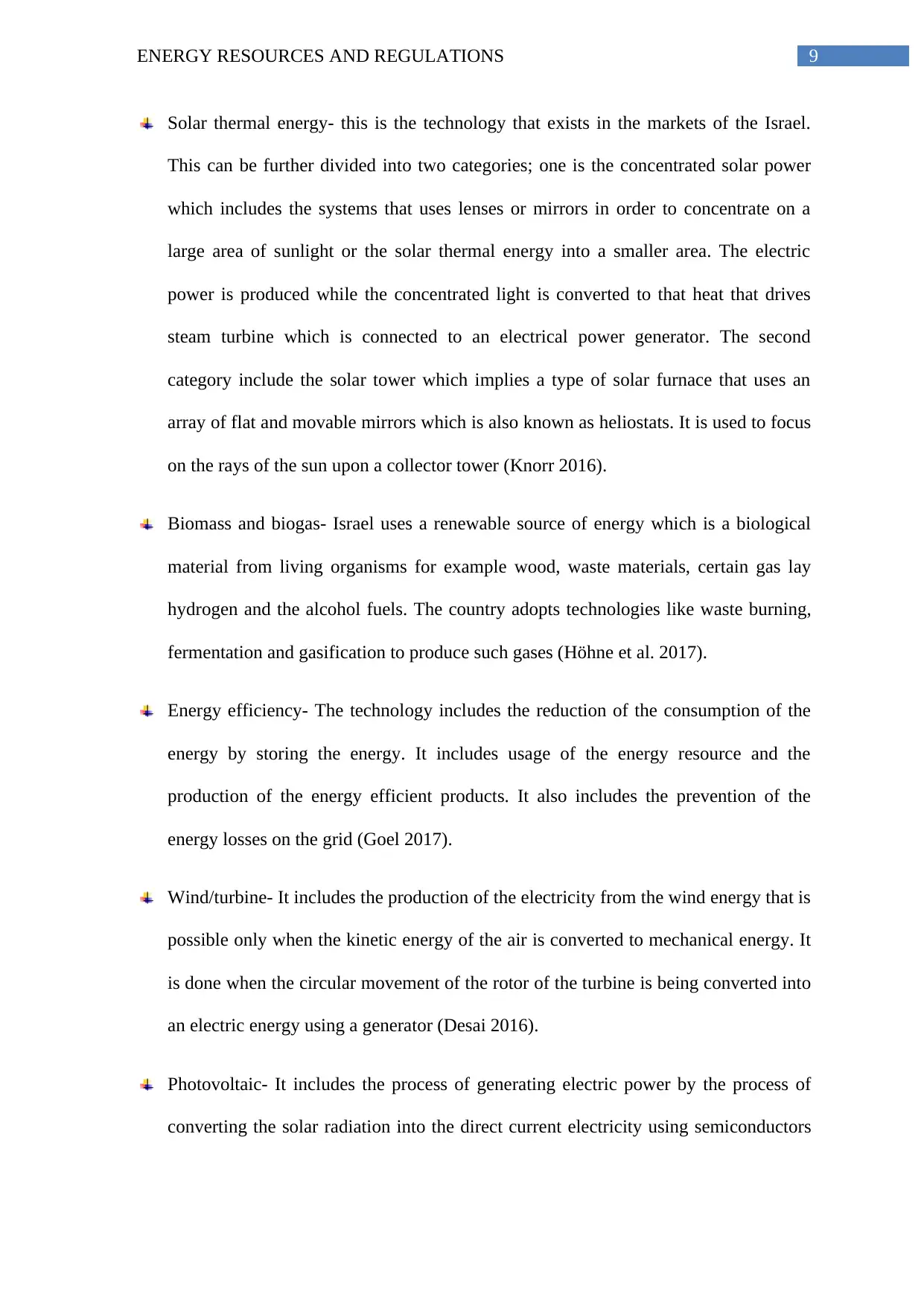
9ENERGY RESOURCES AND REGULATIONS
Solar thermal energy- this is the technology that exists in the markets of the Israel.
This can be further divided into two categories; one is the concentrated solar power
which includes the systems that uses lenses or mirrors in order to concentrate on a
large area of sunlight or the solar thermal energy into a smaller area. The electric
power is produced while the concentrated light is converted to that heat that drives
steam turbine which is connected to an electrical power generator. The second
category include the solar tower which implies a type of solar furnace that uses an
array of flat and movable mirrors which is also known as heliostats. It is used to focus
on the rays of the sun upon a collector tower (Knorr 2016).
Biomass and biogas- Israel uses a renewable source of energy which is a biological
material from living organisms for example wood, waste materials, certain gas lay
hydrogen and the alcohol fuels. The country adopts technologies like waste burning,
fermentation and gasification to produce such gases (Höhne et al. 2017).
Energy efficiency- The technology includes the reduction of the consumption of the
energy by storing the energy. It includes usage of the energy resource and the
production of the energy efficient products. It also includes the prevention of the
energy losses on the grid (Goel 2017).
Wind/turbine- It includes the production of the electricity from the wind energy that is
possible only when the kinetic energy of the air is converted to mechanical energy. It
is done when the circular movement of the rotor of the turbine is being converted into
an electric energy using a generator (Desai 2016).
Photovoltaic- It includes the process of generating electric power by the process of
converting the solar radiation into the direct current electricity using semiconductors
Solar thermal energy- this is the technology that exists in the markets of the Israel.
This can be further divided into two categories; one is the concentrated solar power
which includes the systems that uses lenses or mirrors in order to concentrate on a
large area of sunlight or the solar thermal energy into a smaller area. The electric
power is produced while the concentrated light is converted to that heat that drives
steam turbine which is connected to an electrical power generator. The second
category include the solar tower which implies a type of solar furnace that uses an
array of flat and movable mirrors which is also known as heliostats. It is used to focus
on the rays of the sun upon a collector tower (Knorr 2016).
Biomass and biogas- Israel uses a renewable source of energy which is a biological
material from living organisms for example wood, waste materials, certain gas lay
hydrogen and the alcohol fuels. The country adopts technologies like waste burning,
fermentation and gasification to produce such gases (Höhne et al. 2017).
Energy efficiency- The technology includes the reduction of the consumption of the
energy by storing the energy. It includes usage of the energy resource and the
production of the energy efficient products. It also includes the prevention of the
energy losses on the grid (Goel 2017).
Wind/turbine- It includes the production of the electricity from the wind energy that is
possible only when the kinetic energy of the air is converted to mechanical energy. It
is done when the circular movement of the rotor of the turbine is being converted into
an electric energy using a generator (Desai 2016).
Photovoltaic- It includes the process of generating electric power by the process of
converting the solar radiation into the direct current electricity using semiconductors
Secure Best Marks with AI Grader
Need help grading? Try our AI Grader for instant feedback on your assignments.
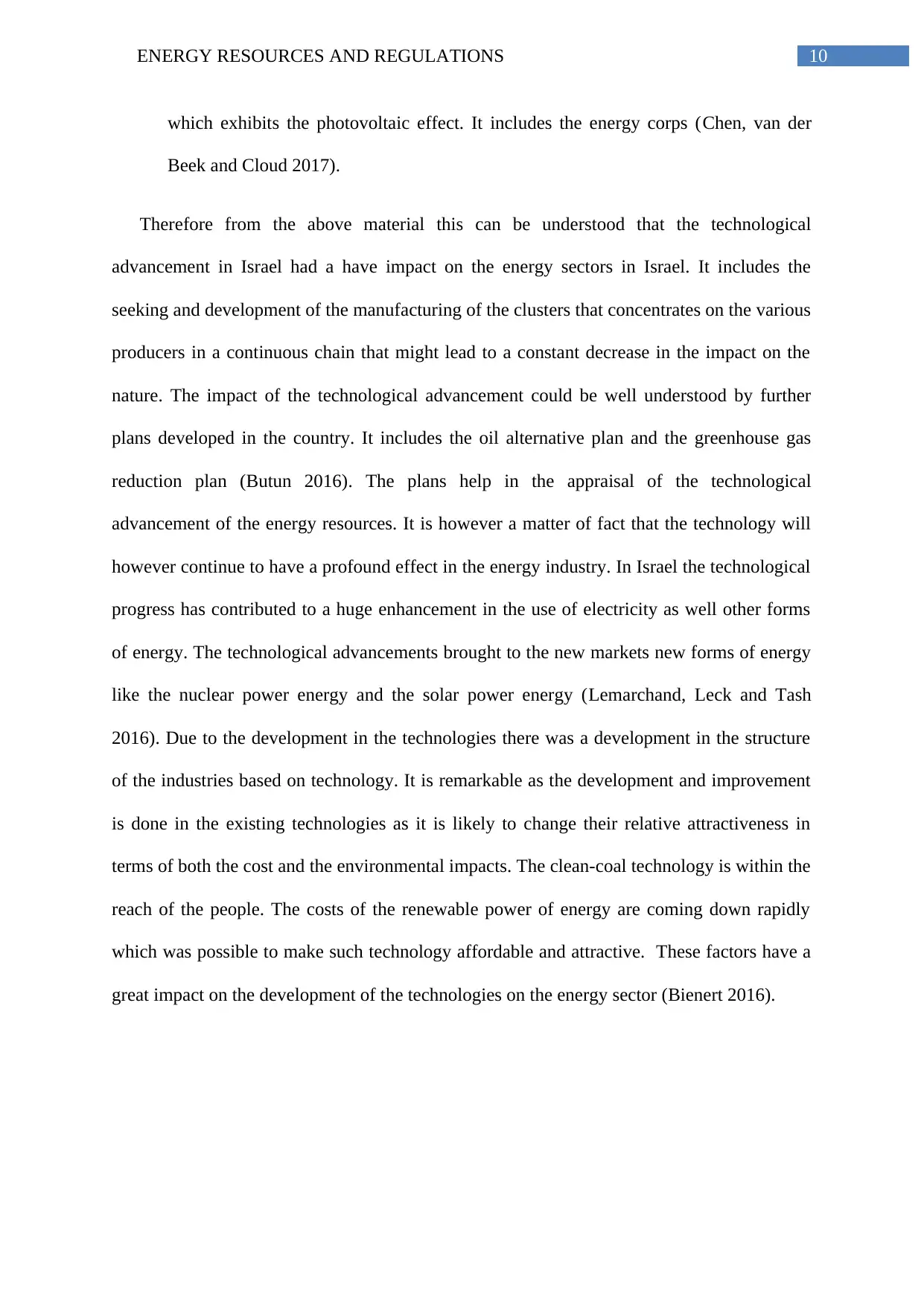
10ENERGY RESOURCES AND REGULATIONS
which exhibits the photovoltaic effect. It includes the energy corps (Chen, van der
Beek and Cloud 2017).
Therefore from the above material this can be understood that the technological
advancement in Israel had a have impact on the energy sectors in Israel. It includes the
seeking and development of the manufacturing of the clusters that concentrates on the various
producers in a continuous chain that might lead to a constant decrease in the impact on the
nature. The impact of the technological advancement could be well understood by further
plans developed in the country. It includes the oil alternative plan and the greenhouse gas
reduction plan (Butun 2016). The plans help in the appraisal of the technological
advancement of the energy resources. It is however a matter of fact that the technology will
however continue to have a profound effect in the energy industry. In Israel the technological
progress has contributed to a huge enhancement in the use of electricity as well other forms
of energy. The technological advancements brought to the new markets new forms of energy
like the nuclear power energy and the solar power energy (Lemarchand, Leck and Tash
2016). Due to the development in the technologies there was a development in the structure
of the industries based on technology. It is remarkable as the development and improvement
is done in the existing technologies as it is likely to change their relative attractiveness in
terms of both the cost and the environmental impacts. The clean-coal technology is within the
reach of the people. The costs of the renewable power of energy are coming down rapidly
which was possible to make such technology affordable and attractive. These factors have a
great impact on the development of the technologies on the energy sector (Bienert 2016).
which exhibits the photovoltaic effect. It includes the energy corps (Chen, van der
Beek and Cloud 2017).
Therefore from the above material this can be understood that the technological
advancement in Israel had a have impact on the energy sectors in Israel. It includes the
seeking and development of the manufacturing of the clusters that concentrates on the various
producers in a continuous chain that might lead to a constant decrease in the impact on the
nature. The impact of the technological advancement could be well understood by further
plans developed in the country. It includes the oil alternative plan and the greenhouse gas
reduction plan (Butun 2016). The plans help in the appraisal of the technological
advancement of the energy resources. It is however a matter of fact that the technology will
however continue to have a profound effect in the energy industry. In Israel the technological
progress has contributed to a huge enhancement in the use of electricity as well other forms
of energy. The technological advancements brought to the new markets new forms of energy
like the nuclear power energy and the solar power energy (Lemarchand, Leck and Tash
2016). Due to the development in the technologies there was a development in the structure
of the industries based on technology. It is remarkable as the development and improvement
is done in the existing technologies as it is likely to change their relative attractiveness in
terms of both the cost and the environmental impacts. The clean-coal technology is within the
reach of the people. The costs of the renewable power of energy are coming down rapidly
which was possible to make such technology affordable and attractive. These factors have a
great impact on the development of the technologies on the energy sector (Bienert 2016).
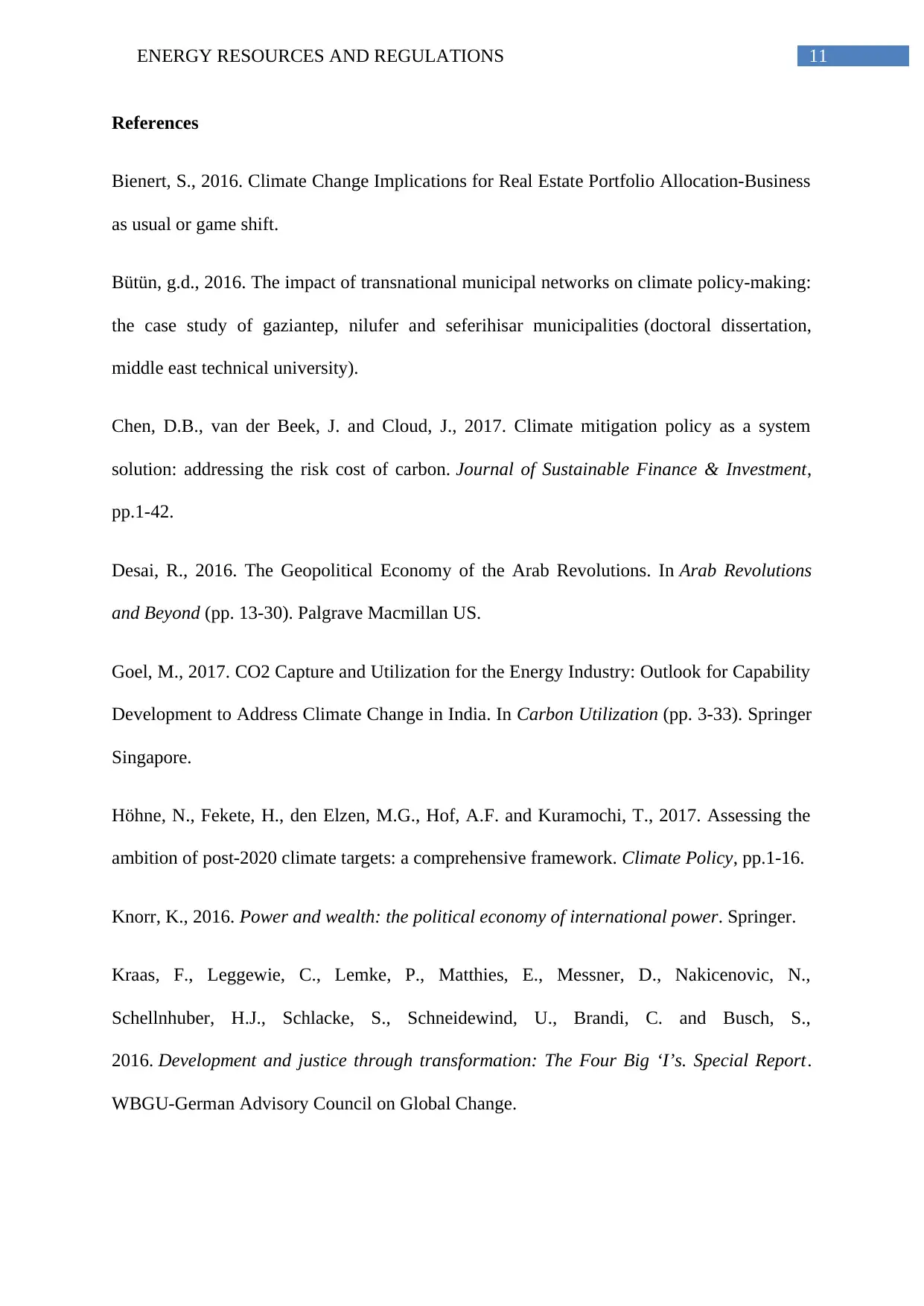
11ENERGY RESOURCES AND REGULATIONS
References
Bienert, S., 2016. Climate Change Implications for Real Estate Portfolio Allocation-Business
as usual or game shift.
Bütün, g.d., 2016. The impact of transnational municipal networks on climate policy-making:
the case study of gaziantep, nilufer and seferihisar municipalities (doctoral dissertation,
middle east technical university).
Chen, D.B., van der Beek, J. and Cloud, J., 2017. Climate mitigation policy as a system
solution: addressing the risk cost of carbon. Journal of Sustainable Finance & Investment,
pp.1-42.
Desai, R., 2016. The Geopolitical Economy of the Arab Revolutions. In Arab Revolutions
and Beyond (pp. 13-30). Palgrave Macmillan US.
Goel, M., 2017. CO2 Capture and Utilization for the Energy Industry: Outlook for Capability
Development to Address Climate Change in India. In Carbon Utilization (pp. 3-33). Springer
Singapore.
Höhne, N., Fekete, H., den Elzen, M.G., Hof, A.F. and Kuramochi, T., 2017. Assessing the
ambition of post-2020 climate targets: a comprehensive framework. Climate Policy, pp.1-16.
Knorr, K., 2016. Power and wealth: the political economy of international power. Springer.
Kraas, F., Leggewie, C., Lemke, P., Matthies, E., Messner, D., Nakicenovic, N.,
Schellnhuber, H.J., Schlacke, S., Schneidewind, U., Brandi, C. and Busch, S.,
2016. Development and justice through transformation: The Four Big ‘I’s. Special Report.
WBGU-German Advisory Council on Global Change.
References
Bienert, S., 2016. Climate Change Implications for Real Estate Portfolio Allocation-Business
as usual or game shift.
Bütün, g.d., 2016. The impact of transnational municipal networks on climate policy-making:
the case study of gaziantep, nilufer and seferihisar municipalities (doctoral dissertation,
middle east technical university).
Chen, D.B., van der Beek, J. and Cloud, J., 2017. Climate mitigation policy as a system
solution: addressing the risk cost of carbon. Journal of Sustainable Finance & Investment,
pp.1-42.
Desai, R., 2016. The Geopolitical Economy of the Arab Revolutions. In Arab Revolutions
and Beyond (pp. 13-30). Palgrave Macmillan US.
Goel, M., 2017. CO2 Capture and Utilization for the Energy Industry: Outlook for Capability
Development to Address Climate Change in India. In Carbon Utilization (pp. 3-33). Springer
Singapore.
Höhne, N., Fekete, H., den Elzen, M.G., Hof, A.F. and Kuramochi, T., 2017. Assessing the
ambition of post-2020 climate targets: a comprehensive framework. Climate Policy, pp.1-16.
Knorr, K., 2016. Power and wealth: the political economy of international power. Springer.
Kraas, F., Leggewie, C., Lemke, P., Matthies, E., Messner, D., Nakicenovic, N.,
Schellnhuber, H.J., Schlacke, S., Schneidewind, U., Brandi, C. and Busch, S.,
2016. Development and justice through transformation: The Four Big ‘I’s. Special Report.
WBGU-German Advisory Council on Global Change.
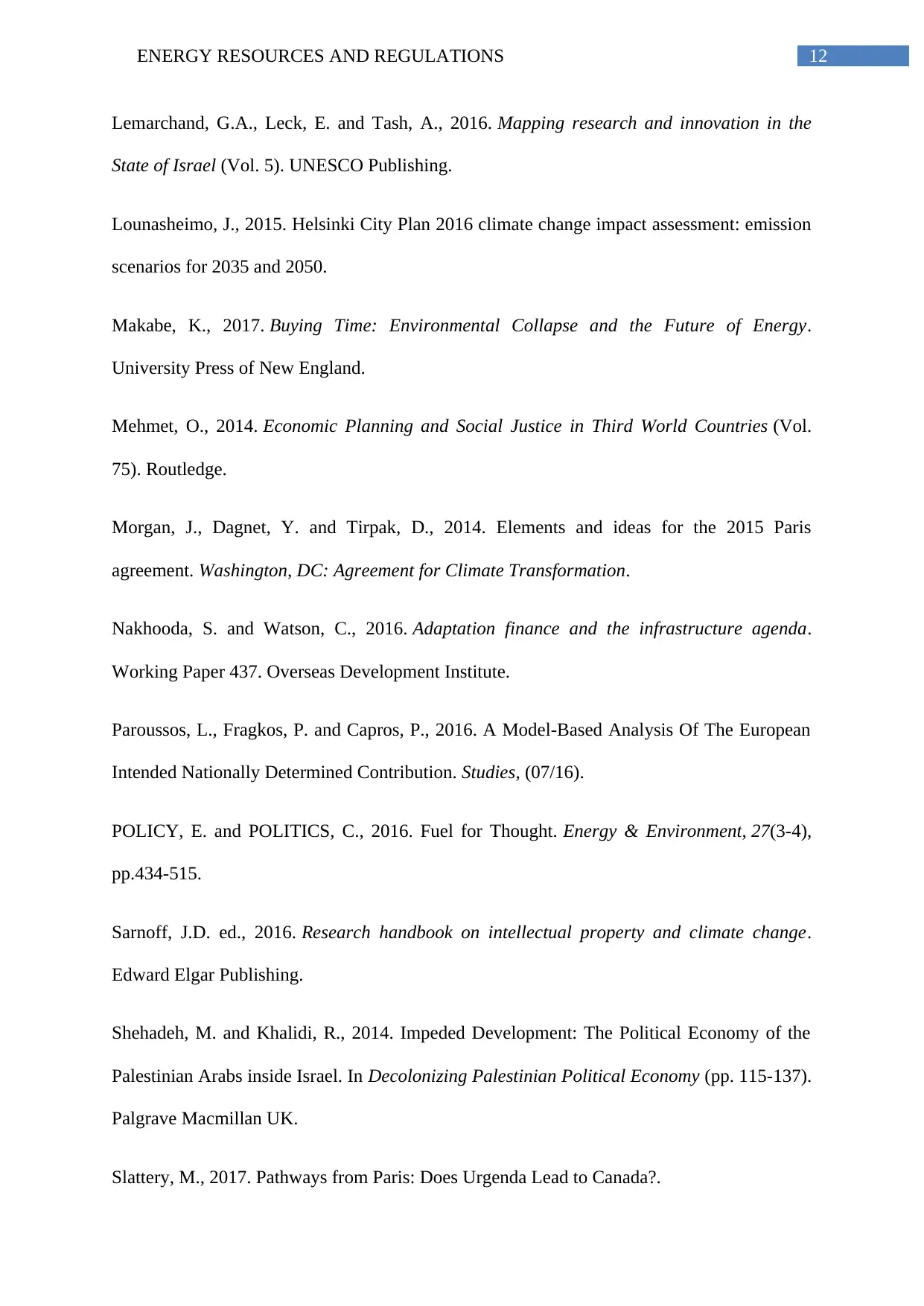
12ENERGY RESOURCES AND REGULATIONS
Lemarchand, G.A., Leck, E. and Tash, A., 2016. Mapping research and innovation in the
State of Israel (Vol. 5). UNESCO Publishing.
Lounasheimo, J., 2015. Helsinki City Plan 2016 climate change impact assessment: emission
scenarios for 2035 and 2050.
Makabe, K., 2017. Buying Time: Environmental Collapse and the Future of Energy.
University Press of New England.
Mehmet, O., 2014. Economic Planning and Social Justice in Third World Countries (Vol.
75). Routledge.
Morgan, J., Dagnet, Y. and Tirpak, D., 2014. Elements and ideas for the 2015 Paris
agreement. Washington, DC: Agreement for Climate Transformation.
Nakhooda, S. and Watson, C., 2016. Adaptation finance and the infrastructure agenda.
Working Paper 437. Overseas Development Institute.
Paroussos, L., Fragkos, P. and Capros, P., 2016. A Model-Based Analysis Of The European
Intended Nationally Determined Contribution. Studies, (07/16).
POLICY, E. and POLITICS, C., 2016. Fuel for Thought. Energy & Environment, 27(3-4),
pp.434-515.
Sarnoff, J.D. ed., 2016. Research handbook on intellectual property and climate change.
Edward Elgar Publishing.
Shehadeh, M. and Khalidi, R., 2014. Impeded Development: The Political Economy of the
Palestinian Arabs inside Israel. In Decolonizing Palestinian Political Economy (pp. 115-137).
Palgrave Macmillan UK.
Slattery, M., 2017. Pathways from Paris: Does Urgenda Lead to Canada?.
Lemarchand, G.A., Leck, E. and Tash, A., 2016. Mapping research and innovation in the
State of Israel (Vol. 5). UNESCO Publishing.
Lounasheimo, J., 2015. Helsinki City Plan 2016 climate change impact assessment: emission
scenarios for 2035 and 2050.
Makabe, K., 2017. Buying Time: Environmental Collapse and the Future of Energy.
University Press of New England.
Mehmet, O., 2014. Economic Planning and Social Justice in Third World Countries (Vol.
75). Routledge.
Morgan, J., Dagnet, Y. and Tirpak, D., 2014. Elements and ideas for the 2015 Paris
agreement. Washington, DC: Agreement for Climate Transformation.
Nakhooda, S. and Watson, C., 2016. Adaptation finance and the infrastructure agenda.
Working Paper 437. Overseas Development Institute.
Paroussos, L., Fragkos, P. and Capros, P., 2016. A Model-Based Analysis Of The European
Intended Nationally Determined Contribution. Studies, (07/16).
POLICY, E. and POLITICS, C., 2016. Fuel for Thought. Energy & Environment, 27(3-4),
pp.434-515.
Sarnoff, J.D. ed., 2016. Research handbook on intellectual property and climate change.
Edward Elgar Publishing.
Shehadeh, M. and Khalidi, R., 2014. Impeded Development: The Political Economy of the
Palestinian Arabs inside Israel. In Decolonizing Palestinian Political Economy (pp. 115-137).
Palgrave Macmillan UK.
Slattery, M., 2017. Pathways from Paris: Does Urgenda Lead to Canada?.
Paraphrase This Document
Need a fresh take? Get an instant paraphrase of this document with our AI Paraphraser
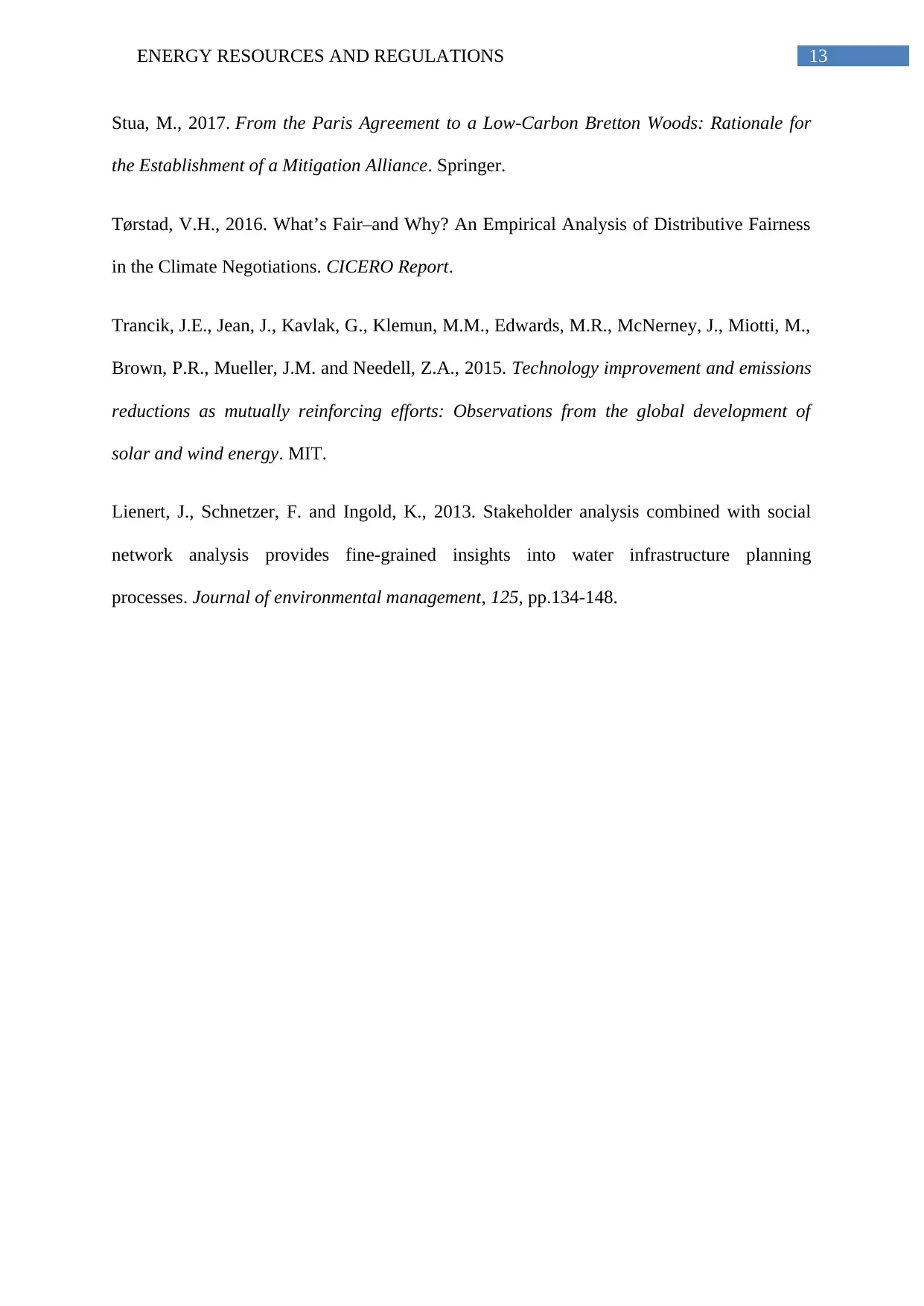
13ENERGY RESOURCES AND REGULATIONS
Stua, M., 2017. From the Paris Agreement to a Low-Carbon Bretton Woods: Rationale for
the Establishment of a Mitigation Alliance. Springer.
Tørstad, V.H., 2016. What’s Fair–and Why? An Empirical Analysis of Distributive Fairness
in the Climate Negotiations. CICERO Report.
Trancik, J.E., Jean, J., Kavlak, G., Klemun, M.M., Edwards, M.R., McNerney, J., Miotti, M.,
Brown, P.R., Mueller, J.M. and Needell, Z.A., 2015. Technology improvement and emissions
reductions as mutually reinforcing efforts: Observations from the global development of
solar and wind energy. MIT.
Lienert, J., Schnetzer, F. and Ingold, K., 2013. Stakeholder analysis combined with social
network analysis provides fine-grained insights into water infrastructure planning
processes. Journal of environmental management, 125, pp.134-148.
Stua, M., 2017. From the Paris Agreement to a Low-Carbon Bretton Woods: Rationale for
the Establishment of a Mitigation Alliance. Springer.
Tørstad, V.H., 2016. What’s Fair–and Why? An Empirical Analysis of Distributive Fairness
in the Climate Negotiations. CICERO Report.
Trancik, J.E., Jean, J., Kavlak, G., Klemun, M.M., Edwards, M.R., McNerney, J., Miotti, M.,
Brown, P.R., Mueller, J.M. and Needell, Z.A., 2015. Technology improvement and emissions
reductions as mutually reinforcing efforts: Observations from the global development of
solar and wind energy. MIT.
Lienert, J., Schnetzer, F. and Ingold, K., 2013. Stakeholder analysis combined with social
network analysis provides fine-grained insights into water infrastructure planning
processes. Journal of environmental management, 125, pp.134-148.
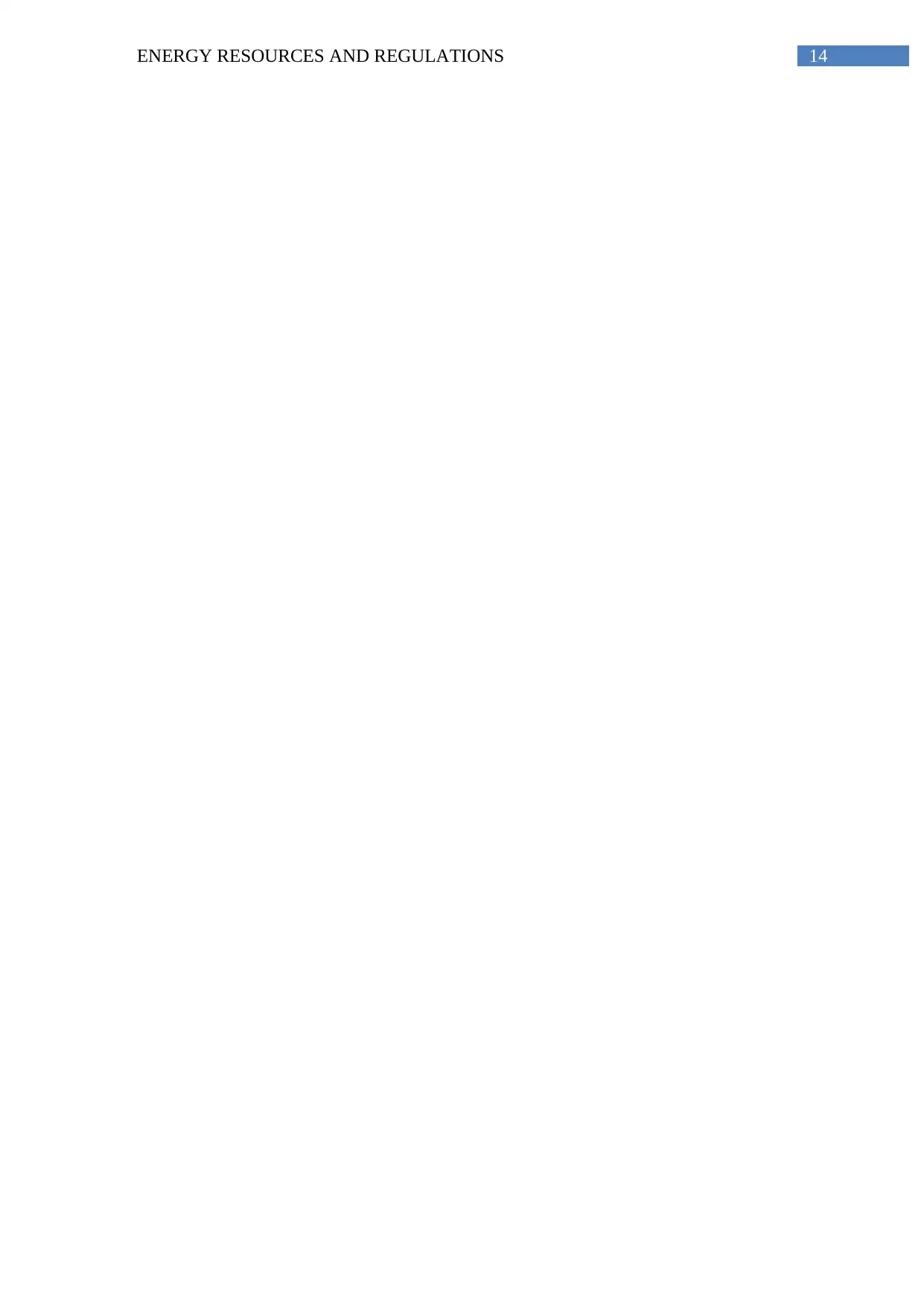
14ENERGY RESOURCES AND REGULATIONS
1 out of 15
Related Documents
Your All-in-One AI-Powered Toolkit for Academic Success.
+13062052269
info@desklib.com
Available 24*7 on WhatsApp / Email
![[object Object]](/_next/static/media/star-bottom.7253800d.svg)
Unlock your academic potential
© 2024 | Zucol Services PVT LTD | All rights reserved.





